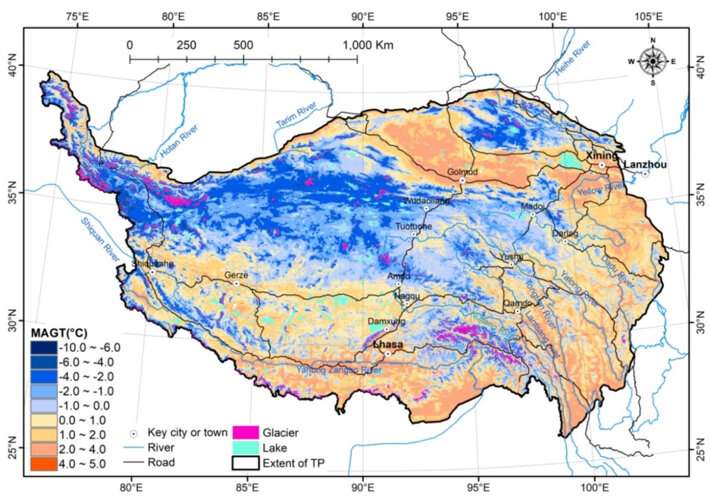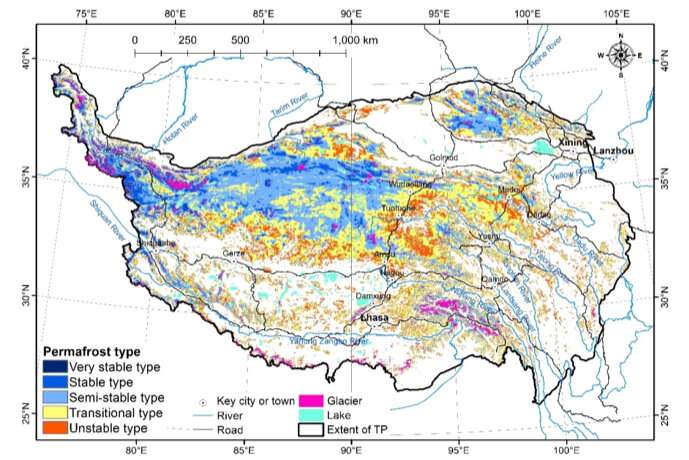New permafrost thermal stability map better describes the permafrost on the Tibetan Plateau

The Tibetan Plateau (TP), which is sometimes called "Earth's third pole," is the highest and most extensive plateau in the world. TP is well known as the "Asian water tower," as it is the largest permafrost region among middle- and low-latitude regions in the world. The average temperature of permafrost on the TP is approximately -2 C, this warm permafrost is more sensitive to climate change and human disturbance than that in Arctic. However, the degradation of permafrost may affect the stability of this region. Mapping the permafrost on the TP is therefore of critical importance.
Due to the harsh natural environment, the ground measurement data such as mean annual ground temperature (MAGT) at a depth of zero annual amplitude (10-25 m) in permafrost area of TP is very limited, which leads to the large uncertainty of permafrost map in this area. With the accumulation of ground observation data and remote sensing big data, it is possible to mapping the permafrost at TP with a high accuracy.
Recently, Youhua Ran from Northwest Institute of Eco-Environment and Resources, Chinese Academy of Sciences at Lanzhou, China, Xin Li from Institute of Tibetan Plateau Research, Chinese Academy of Sciences at Beijing, China, and their collaborators collected and compiled MAGT measurement data at 237 boreholes that widely distributed over the TP.
These in situ MAGT data were integrated with remotely sensed freezing degree-days and thawing degree-days, snow cover days, leaf area index, soil bulk density and high-accuracy soil moisture data by using an ensemble learning method that employs a support vector regression model based on distance-blocked resampled training data with 200 repetitions. Cross-validation indicates that it is probably the most accurate of all currently available MAGT data, as shown in Figure 1.

In order to better describe the permafrost in the Tibet Plateau, this map uses a new permafrost zoning scheme. The high-altitude permafrost zoning system was proposed by Guodong CHENG. This system based on MAGT is not only closely related to the permafrost thickness, the vertical connectivity, and the development degree of periglacial landform, but also reflects the permafrost thermal stability, which is important in environment and engineering applications.
Based on the predicted mean annual ground temperature (MAGT) at a depth of zero annual amplitude (10-25 m) and the high altitude permafrost zoning system, the permafrost in TP was divided into very stable, stable, semi-stable, transitional, and unstable (Figure 2). According to this map, the total area of permafrost on the TP, excluding glaciers and lakes, is approximately 115.02*104 km2. The areas corresponding to the very stable, stable, semi-stable, transitional, and unstable types are 0.86*104, 9.62*104, 38.45*104, 42.29*104, and 23.80*104 km2, respectively. The new permafrost stability map is of fundamental importance for supporting engineering planning and design measures intended to reduce permafrost-related hazards and to enhance water resource management. It is also can be used to evaluate "third pole" permafrost change in the future on the as a baseline.
More information: Youhua Ran et al, Mapping the permafrost stability on the Tibetan Plateau for 2005–2015, Science China Earth Sciences (2020). DOI: 10.1007/s11430-020-9685-3
Journal information: Science China Earth Sciences
Provided by Science China Press


















